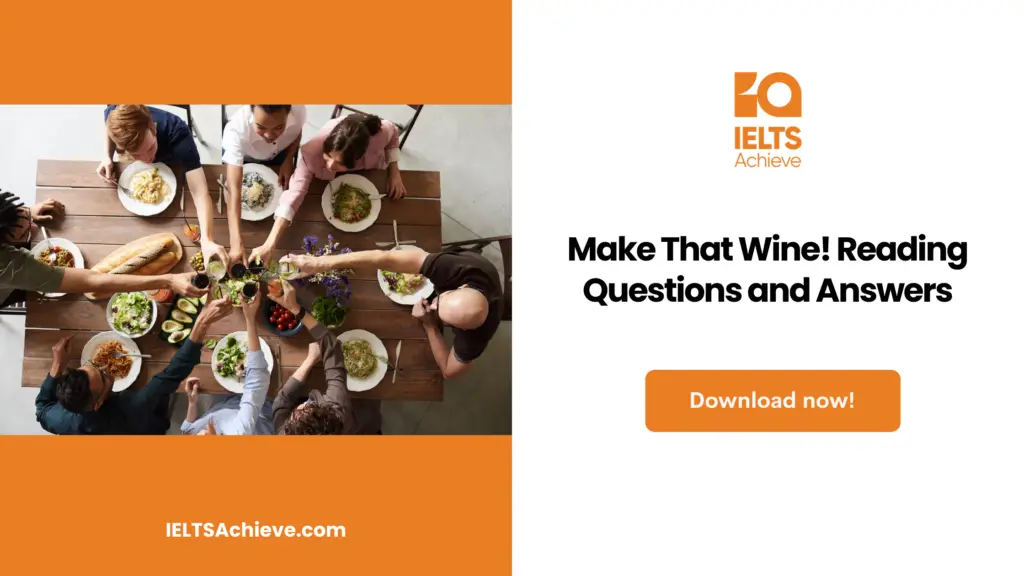The Blog post contains the following IELTS Reading Questions:
- IELTS Reading Multiple Choice Questions
- IELTS Reading True/False/Not Given
- IELTS Reading Table Completion
Stay informed and prepared for success – Explore our comprehensive Reading Test Info page to get valuable insights, exam format details, and expert tips for mastering the IELTS Reading section.
IELTS Reading Passage – Make That Wine!

Make That Wine!
Australia is a nation of beer drinkers. Actually, make that wine. Yes, wine has now just about supplanted beer as the alcoholic drink of choice, probably because of the extensive range of choices available and the rich culture behind them. This all adds a certain depth and intimacy to the drinking process which beer just cannot match. In addition, although wine drinkers seldom think about it, moderate consumption seems to be beneficial for the health, lowering the incidence of heart disease and various other ailments.
Wine is the product of the fermentation of grape juice, in which yeast (a fungus) consumes the natural sugars within, producing alcohol and carbon dioxide as waste. Yeast grows naturally on many varieties of grapes, often visible as a white powder, and causing fermentation directly on the plant. Thus, the discovery of wine-making was inevitable at some stage in human history. The evidence shows that this was at least 8,000 years ago in the Near East. From there, wine-making spread around the ancient Mediterranean civilisations, where the liquid was extensively produced, drunk, and traded. To this day, the biggest drinkers of wine remain the Mediterranean countries, with France leading the way.
This leads to the classification of wines, which is quite complex. It often begins with the colour: red or white. Most people do not know that the colour of wine is not due to the grapes used (whose skins are either green or purple), but to the wine-making process itself. All grape juice is clear. Red wines are produced by leaving the grape skin in contact with the juice during fermentation; white wines by not doing so. Thus, white wine can be made from dark-coloured grapes, provided that the skin is separated early, although the resultant wine may have a pinkish tinge.
A similar wine classification is based more specifically on the grape species used, giving such well-known names as Pinot Noir and Merlot. Chardonnay grapes remain one of the most widely planted, producing an array of white wines, rivaling the cabernet sauvignon grape, a key ingredient in the world’s most widely recognised, and similarly named, red wines. When one grape species is used, or is predominant, the wine produced is called varietal, as opposed to mixing the juices of various identified grapes, which results in blended wines. The latter process is often done when wine-makers, and the people who drink their product, want a consistent taste, year after year. Far from being looked down upon, it often results in some of the world’s most expensive bottles, such as the Cote Rotie wines in France.
Increasingly, however, market recognition is based on the location of the wine production, resulting in labels such as Bordeaux in France, Napa Valley in California, and the Barossa Valley in Australia. Traditional wines made in these places carry trademarks, respected by serious wine drinkers. However, an example of the blurred lines is the term ‘champagne’. This was once expected to be made from grapes grown in the Champagne region of France, with all the expertise and traditions of that area, but, despite legal attempts to trademark the term, it has become ‘semi-generic’, allowing it to be used for any wine of this type made anywhere in the world.
Finally, we come to the vinification method as a means of classification. One example is, in fact, champagne, known as a ‘sparkling’ wine. By allowing a secondary fermentation in a sealed container, it retains some of the waste carbon dioxide. Another variation is to stop the fermentation before all the natural sugars are consumed, creating dessert wines, ranging from slight to extreme sweetness. Yet again, grapes can be harvested well beyond their maximum ripeness, creating ‘late harvest wines’, or allowed to become partially dried (or ‘raisoned’), creating ‘dried grape wines’. Clearly, there are many possibilities, all producing uniquely flavoured products.
One of the best-known terms relating to wine is ‘vintage’. This signifies that the product was made from grapes that were grown in a single labeled year. If that year is eventually acknowledged to have produced exceptionally fine grapes and resultant wines (‘a good vintage’), bottles from that period are often saved for future consumption. Of course, the appreciation and assessment of wine is an inexact science, meaning that the significance of a particular vintage often promotes much speculation and disagreement. A non-vintage wine is usually a blend from the produce of two or more years, which is done, as mentioned before, for consistency and quality control.
This leads to the rich and varied world of wine assessment, and its descriptive terminology. Wine has such a variety of aromas, flavours, textures, and aftertastes that serious wine drinkers demand an agreed vocabulary so that the drinking sensations can be reliably described in writing. From bouquet to biscuity, mellow to musky, vivid to vegetal, the conceited connoisseur can perplex the listener with some really purple prose. Perhaps the opportunity to posture pretentiously with all this jargon is the main reason why wine enthusiasts are so taken with this product. Cheers!
Unlock your full potential in the IELTS Reading section – Visit our IELTS Reading Practice Question Answer page now!
Recommended Questions:
Renewable Energy IELTS Reading Question with Answer
Questions 1-4
Do the following statements agree with the information given in Reading Passage One? Write
TRUE if the statement agrees with the information
FALSE if the statement contradicts the information
NOT GIVEN If there is no information on this
1. Wine is popular in Australia because it is healthy.
2. Yeast is white-coloured.
3. Wine is popular in the Near East.
4. Blended wines are usually cheaper.
Enhance your skills in identifying information as True, False, or Not Given. Click here to discover expert strategies and techniques for mastering this question type in the IELTS Reading section.
Questions 5-10
Complete the table. Choose NO MORE THAN TWO WORDS from the passage for each answer.
| Classification based on | Associated fact | Related example |
| Colour | red wines use (5)…………………in fermentation | (6)………………. |
| Grape species | can be (7)…………………or blended | Cote robe wines |
| Location | drinkers of wine (8)………………this | Barossa Valley |
| (9)…………………….. | can allow (10)…………………to remain | Dessert wine |
Boost your performance in Summary, Notes, Table, and Flowchart Completion tasks. Click here to explore our detailed guide and learn how to effectively complete summaries, notes, tables, and flowcharts in the IELTS Reading section.
Questions 11-13
Choose the correct letter, A, B, C, or D.
11. Vintage wines are
A mostly better.
B often preferred.
C often discussed.
D more costly.
12. The author thinks that wine terminology is
A unnecessary.
B serious.
C good.
D bad.
13. Wine
A is more popular than beer, in Australia.
B is most popular in France.
C can be simply classified.
D is often ‘raisoned’.
Ready to improve your performance in Multiple Choice Questions (MCQs)? Click here to access our comprehensive guide on how to tackle MCQs effectively in the IELTS Reading section.
Unlock your full potential in the IELTS Reading section – Visit our IELTS Reading Practice Question Answer page now!
Recommended Questions:
Renewable Energy IELTS Reading Question with Answer

We hope you found this post useful in helping you to study for the IELTS Test. If you have any questions please let us know in the comments below or on the Facebook page.
The best way to keep up to date with posts like this is to like us on Facebook, then follow us on Instagram and Pinterest. If you need help preparing for the IELTS Test, join the IELTS Achieve Academy and see how we can assist you to achieve your desired band score. We offer an essay correction service, mock exams and online courses.

